Picking shade trees for your home landscape can be a challenging process. I have seen countless questions on this subject in my first 10 years at Grimm’s Gardens. Now, as a horticulturalist and tree expert, I get the happy job of helping others find the perfect tree for their yard. Most people have a moderate idea of what tree they want, without knowing their site conditions quite right.
Learning to identify microclimates within your landscape in relation to where you want to add trees is the first step to picking a shade tree for it. Once you have that down, learning the soil type, wind severity, and exposure (to sun or shade), you can pick a suitable tree.
Besides site conditions, things to remember when picking a tree include fall color, fruiting, flower color, size, disease and insect susceptibility, durability, and maturity. But mostly, consider how much care you are willing to put into the tree. Remember, the best time to plant a tree is 10 years ago, the second best time is now.
The following guide will help you choose the best tree for your location. These trees are ones that grow well in the Central Great Plains Region, Zones 5 to 6. They are grouped into 2 categories for easier use, fast growing, and variable rate growing.
FAST GROWING SHADE TREES
Fast growing trees are ones which can grow at a rate of as much as 6 feet a year or more, but usually grow from between 3 to 6 feet per year. Often, but not always, fast growing trees produce poor branch structures, or have brittle stems. But others are sturdy, just taking advantage of good growing weather and rain.
Kentucky Coffeetree
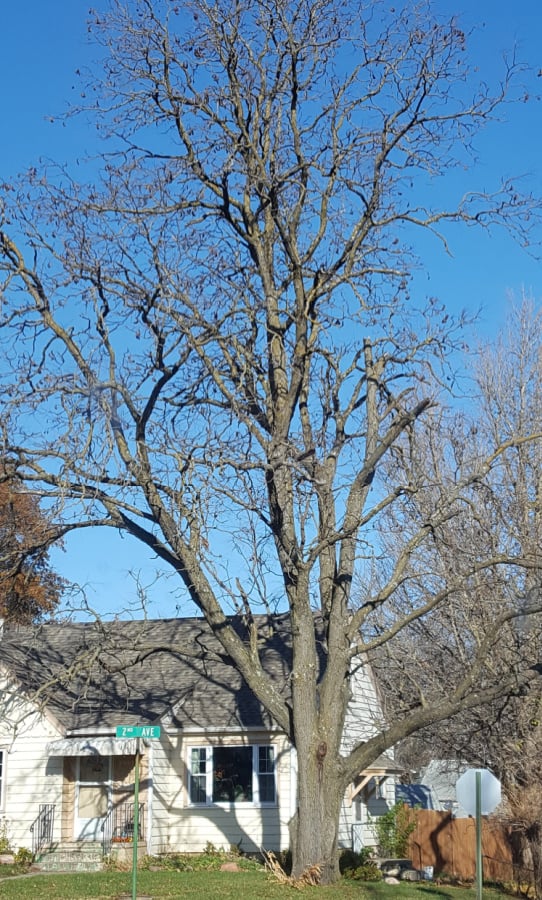
Although considered by many to be slow-growing, here in Northeast Kansas, it is a faster growing tree. In my own yard, I have 3 trees, and they all have grown between 2 and 4 feet per year. Coffeetrees do not produce the same, tropical coffee we drink, though the hard seeds can be roasted as a substitute for coffee.
- Grows 60 to 80 feet tall and wide
- Prefers well-drained soil, but is adaptable to heavy clay. Will not tolerate standing water.
- Flowers are greenish-white and fragrant, but small. Trees are male or female. Brown-black, 6 to 8 inch pods are produced on the female trees.
- Fall color is yellow. Leaves are bi-pinnately compound.
- There are no serious disease or insect pest issues.
- Kentucky coffeetree is a host plant for Eastern tiger swallowtails and some moth species.
- Good cultivars: ‘Espresso‘
Hybrid Maples
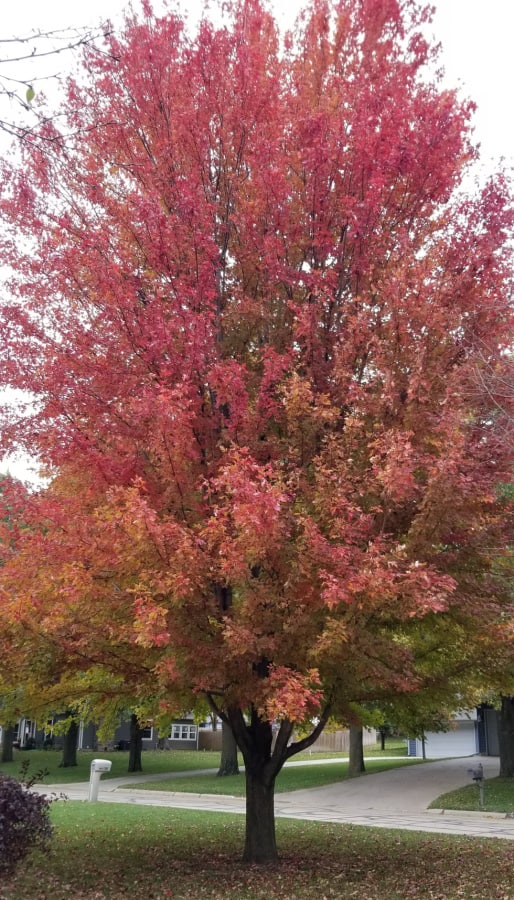
There are now several varieties of hybrid “Freeman” maples, after the craze of the Autumn Blaze maple. While they are very fast growers, sometimes growing as much as 4 to 6 feet per year, they have some issues with fall color stabilization and codominance branching. The Matador maple is an improved selection of Autumn Blaze.
- Grows 40 to 60 feet tall and wide.
- Prefers well-drained to moist soil. Can survive flooding for a few weeks, but roots may be compromised. Tolerant of heavy clay soils.
- Flowers are red or yellow, not very showy. Seeds are winged samaras that can be messy on some cultivars.
- Fall color varies per cultivar. Can be red, orange, or yellow, or some mixture of each.
- No serious pest or disease issues. Can be crippled by codominant stems, or poor color stability. The bark is highly susceptible to winter sunscald.
- Can be a host for several species of moth, gall wasps, and aphids.
- Good cultivars: ‘Matador‘, ‘Firefall’, ‘Sienna Glen’
River Birch
River birch is native to the southeastern United States, but is quite adaptable across the Great Plains regions, even to Zones 4. There are many available cultivars and the bark is richly textured. They grow between 2 and 4 feet per year, more in very wet seasons. I love the river birch’s bark in the landscape, and they make good shade trees.
- They grow 40 to 70 feet tall and wide. They are vase shaped in growth, making for good shade.
- River birches prefer moist to well-drained soils. They are tolerant of heavy clay and can take some standing water.
- Flowers are catkins, which are not showy. They rarely produce viable seeds in landscape settings. The seeds are small and nearly invisible.
- Fall color is yellow to brown.
- No serious disease or insect pest problems. They are fairly resistant to Bronze birch borer. However, they do have some issues with high pH soils and can get iron chlorosis. Anthracnose can be an issue in wet years.
- Host plant for 45 species of moth and the mourning cloak butterfly.
- Good cultivars: ‘Heritage‘
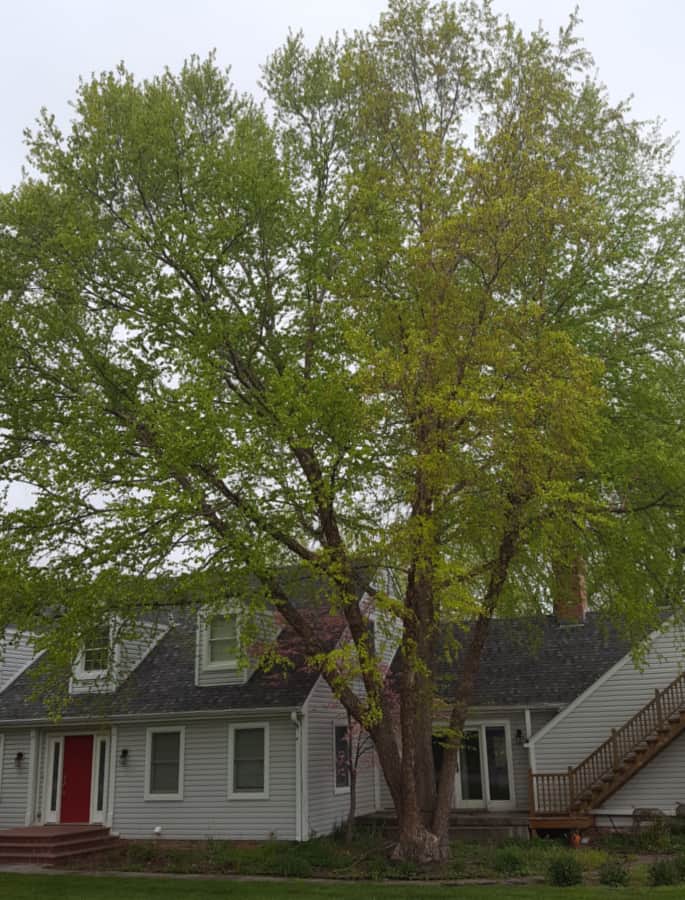
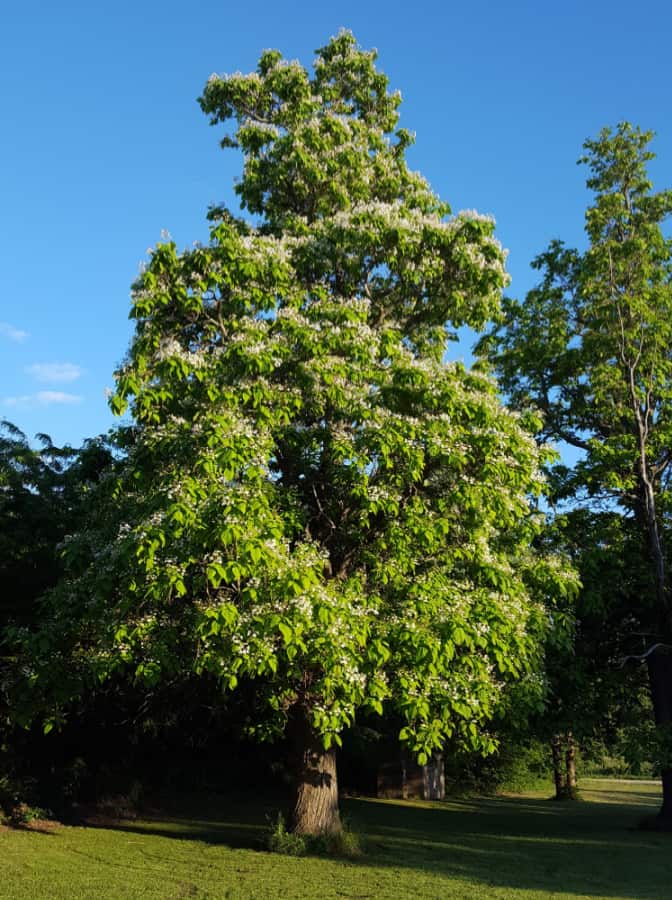
Northern Catalpa
This tree easily resembles a large, tropical tree because of its large leaves. The leaves themselves can be 10 inches wide and up to 16 inches long! Mostly growing with a narrow, upright habit, they can still be wide. Indeed, the state champion is more than 80 feet wide. Catalpa trees grow 3 to 6 feet per year, shooting upwards quickly. Because of their fast growth, railroads used to plant groves of catalpas along the railroad line for ties.
- They grow on average, 40 to 70 feet tall and wide, but there are much larger specimens. Shape is usually oval.
- Catalpas grow best in well-drained to moist soils, and are tolerant of heavy clay. They are somewhat tolerant of seasonal flooding.
- The flowers are large, showy, and mildly fragrant. Long, bean-like seedpods follow the flowers.
- Fall color is usually brown, rarely yellow.
- They have no serious disease or insect pest problems. However, the catalpa sphinx moth may eat large portions of the leaves.
- Good cultivars: ‘Heartland‘
American Sycamore
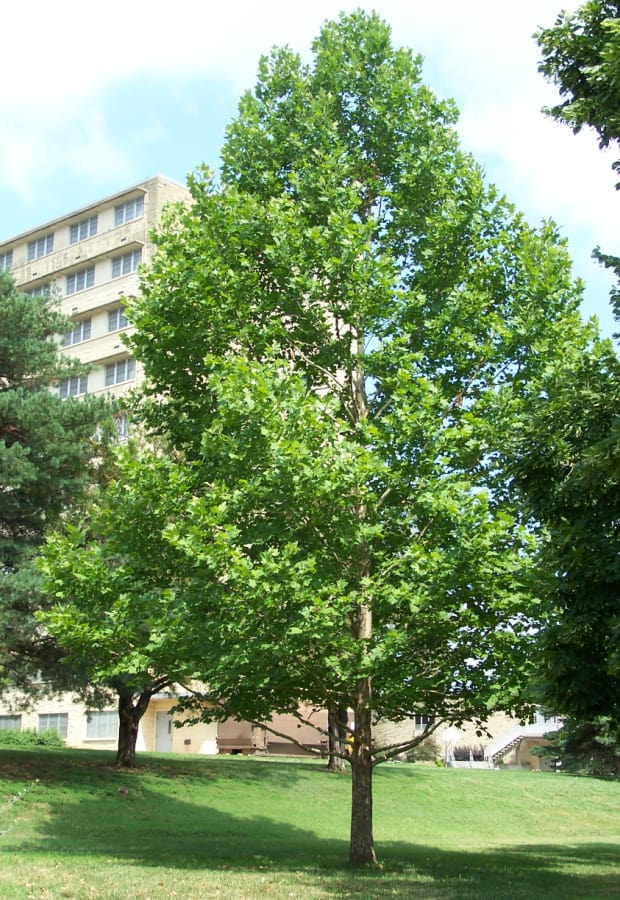
The American sycamore, is one of our largest trees in the Central Great Plains region. Native along streambanks, it competes with the cottonwood for size and strength. They can grow from 2 to 6 feet per year, depending on location and water availability. The bark is beautiful, papery green and white, flaking off in large sections. Leaves can be quite large, 6 to 10 inches across.
- The American sycamore grows 75 to 100 feet tall and wide, dominating any landscape.
- They do best in well-drained to almost wet soils, and can take both standing water and flooding. Also, they are adaptable to dry and clay soils.
- Flowers are greenish white, not showy. Seedpods are hard balls which can be messy.
- Fall color is usually brown.
- Sycamore anthracnose is a regular issue which causes premature leaf and twig drop. Twig cankers are also an issue. There are no serious insect pests, though Japanese beetles may feed on the leaves.
- Several moths use the American sycamore as a host plant.
- Good cultivars: ‘Old Bones‘, ‘KC Snow’
Eastern Cottonwood
Now, most people would not think of a cottonwood as a shade tree. But, being a large tree, and fast growing, makes them a good pick for shade. I have 2 large cottonwoods in my yard and they provide plenty of shade. When young, a cottonwood may grow between 3 and 6 feet per year.
- The eastern cottonwood grows 75 to 120 feet tall and wide.
- Cottonwoods grow best in well-drained to moist soils, but can adapt to heavy clay. They can also handle flooding and standing water.
- Flowers of the cottonwood are catkins and not showy. Seedpods are on female trees only and they are messy in white, cottony fluffs.
- Fall color is brilliant gold to yellow, rarely brown or reddish.
- Cottonwood’s biggest downfall is its brittle stems which break off in high winds and ice storms. There are no serious diseases or insect pests.
- There are at least 50 species of moth and 4 of butterfly which utilize cottonwood as a host plant.
- Good cultivars: ‘Souixland‘, ‘KC Paul Bunyan’
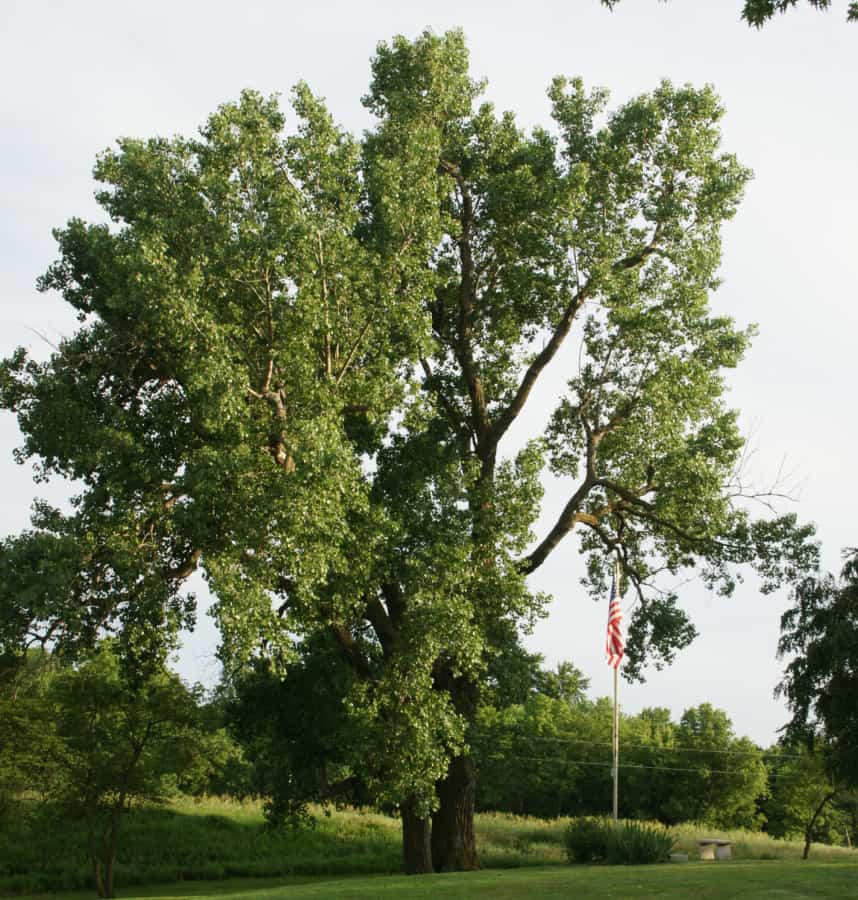
Baldcypress
The baldcypress is one of my favorite large trees. They have cinnamon-colored peeling bark, soft green leaves, and a pyramidal shape. Baldcypress grows 2 to 4 feet per year. In very wet or standing water, they produce “knees” which are root protrusions that help the tree gather oxygen. Also, they are coniferous, meaning they produce seeds in cones, like pines. But they are deciduous too.
- The baldcypress grows 50 to 100 feet tall and wide. It is strongly pyramidal in shape until its later years.
- It grows well in almost any soil type, and is tolerant of standing water and flooding.
- Flowers are greenish and not showy. Seeds are borne in round cones about the size of a golf ball.
- Fall color is usually reddish orange to brown.
- There are no serious disease issues. Bagworms may be an issue on the leaves.
- Only a few moth species use it as a host plant.
- Good cultivars: ‘Shawnee Brave‘
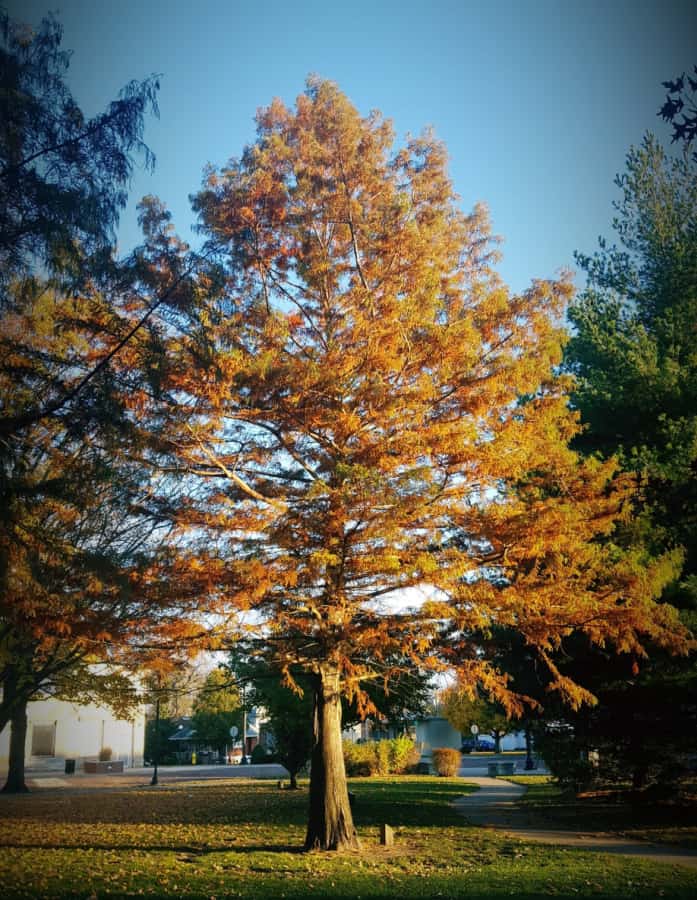
American Linden (Basswood)
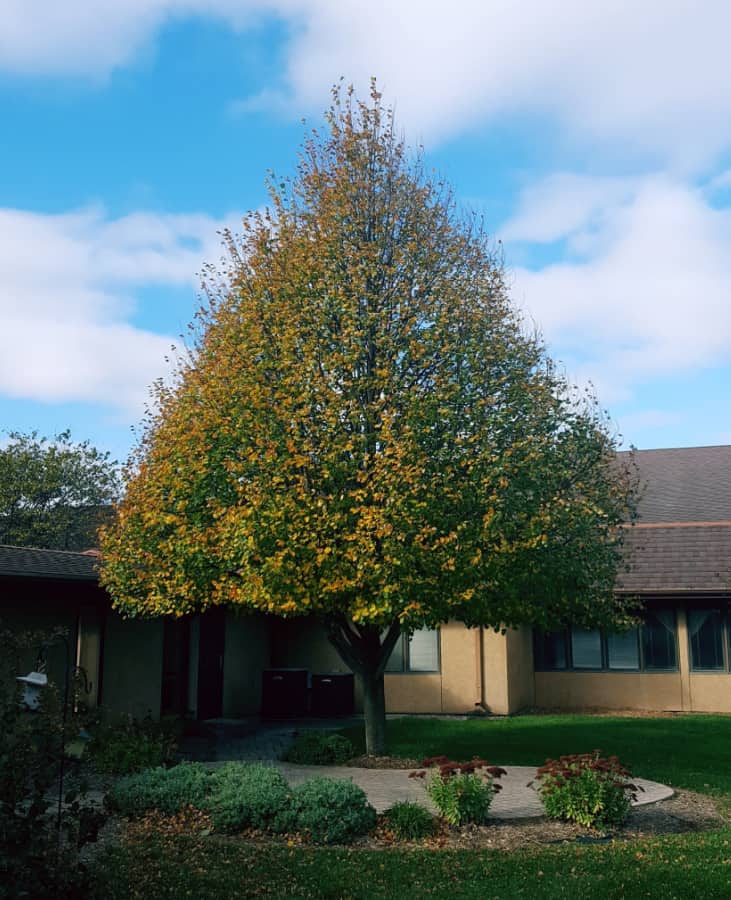
The American linden is one of the most unassuming trees in the woods, it just seems to blend in. I love finding these large trees in the woods, and the landscape. Despite linden’s reputation for being eaten heavily by Japanese beetles, there is some evidence that they mostly avoid the American linden, preferring the alien littleleaf linden. They grow 2 to 4 feet per year.
- The American linden grows 60 to 100 feet tall and wide, with a very rounded crown shape.
- It grows well in well-drained soil, heavy clay, and moist soil. It is tolerant of seasonal flooding.
- The flowers are yellowish and somewhat showy. They are very fragrant and attract many pollinators. The seeds are small and attached to a papery sheath.
- Fall color is yellow.
- There are no major diseases or insect pests of the American linden.
- At least 25 moth species use the linden as a host plant.
- Good cultivars: ‘Redmond’, ‘KC Beekeeper’
American Elm
The American elm once graced the streets of the Midwest and Great Plains regions, before the introduction of Dutch Elm Disease. Since then, cultivars have been produced from resistant trees and by crossing with other species of elms. Now, we have several good cultivars to plant again in our landscapes. Perhaps the fastest growing tree to choose, American elms can grow 4 to 8 feet per year, but need to be trimmed accordingly.
- American elms grow 60 to 100 feet tall and wide with a vase-shaped spread.
- They grow best in well-drained soil, but do adapt to heavy clay. They are not tolerant of flooding, but are so of drought.
- The flowers are insignificant, and the seeds are small, rounded samaras.
- Fall color is typically yellow, sometimes brown.
- Dutch elm disease is a problem on native trees, but most cultivars are very resistant to the disease. There are no major insect pests.
- At least 20 moths and 3 butterflies use American elm as a host plant.
- Good cultivars: ‘Princeton‘, ‘Prairie Expedition’
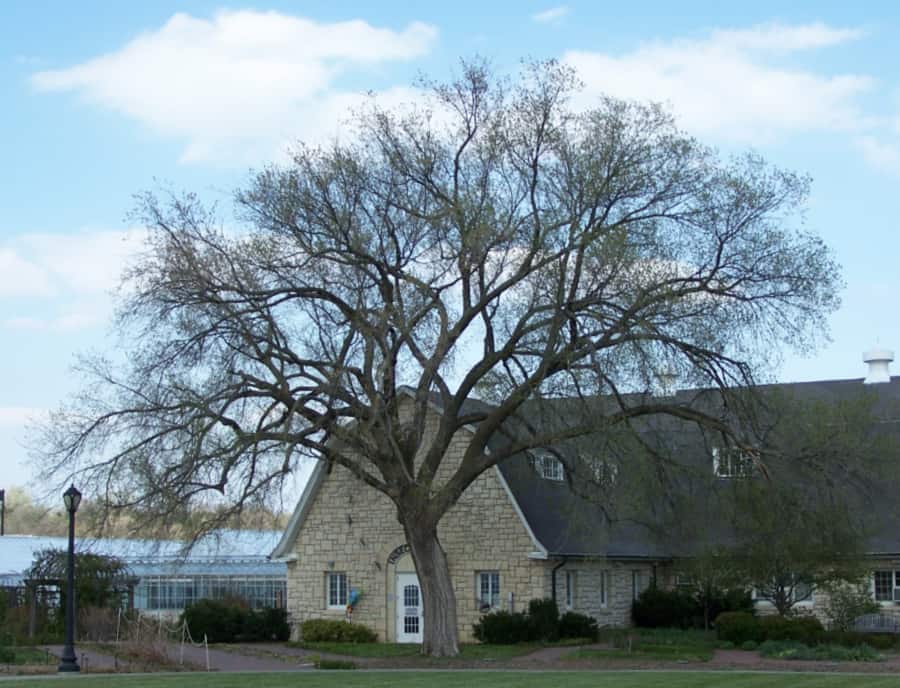
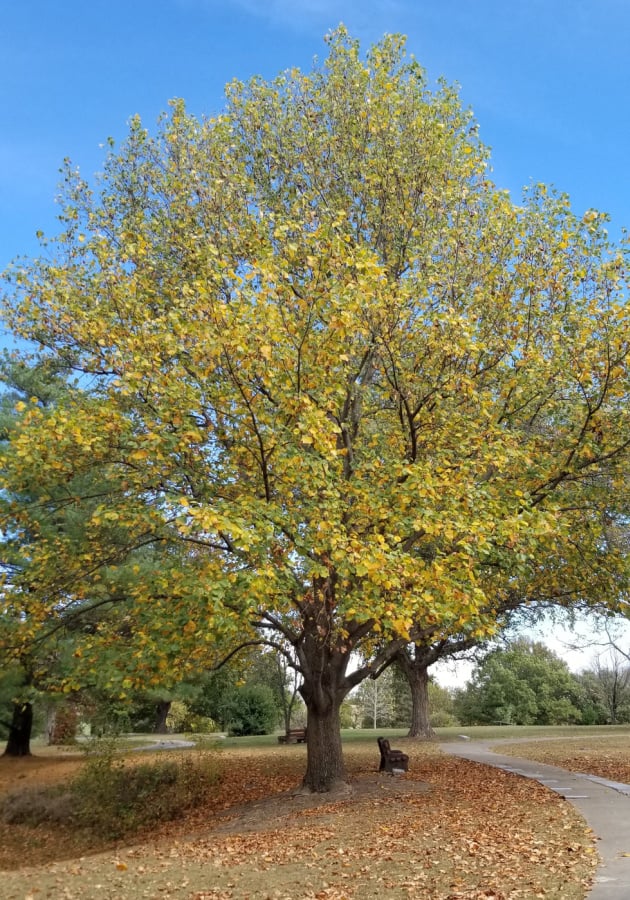
Tulip Tree
The tulip tree, also known as the tulip poplar, is a large tree with a pyramidal shape and very unique flowers. Since the loss of the American elm in eastern deciduous forests, the tulip tree has thrived, filling in gaps. It grows 2 to 4 feet per year, with unique, square leaves.
- The tulip tree grows 80 to 100 feet tall by 60 to 80 feet wide.
- It grows best in well-drained soils, but it adaptable to heavy clay and moist soil.
- Flowers are greenish-yellow and very showy. The seeds are small samaras that can be messy from a large tree.
- Fall color is usually yellow to brown.
- There are no major diseases or insect pests.
- Only a handful of moths and a few butterflies use tulip tree as a host plant.
- Good cultivars: ‘Little Volunteer‘, ‘Emerald City‘
OTHER SHADE TREES
The above trees are the fastest growing shade trees for the Central Great Plains region, but all of the following trees are just as good for shade. Though they may have more varied rates of growth, there are perhaps a few more with better fall color, or better as host plants.
Bitternut Hickory
Although not thought of much as a shade tree, it is perhaps the straightest trunked tree I have observed. The smooth bark and small leaves make it an excellent landscape tree, despite the nuts, which are also small. It grows 1 to 3 feet per year.
- Bitternut hickory grows 40 to 80 feet tall and 40 to 60 feet wide with an oval crown.
- Adaptable to heavy clay, it grows best in moist to well-drained soils.
- The flowers are small and insignificant. Nuts are small and not edible, but liked by squirrels and birds.
- Fall color is yellow.
- There are no significant diseases or pest issues.
- At least 36 moths and 3 butterflies use the bitternut hickory as a host plant.
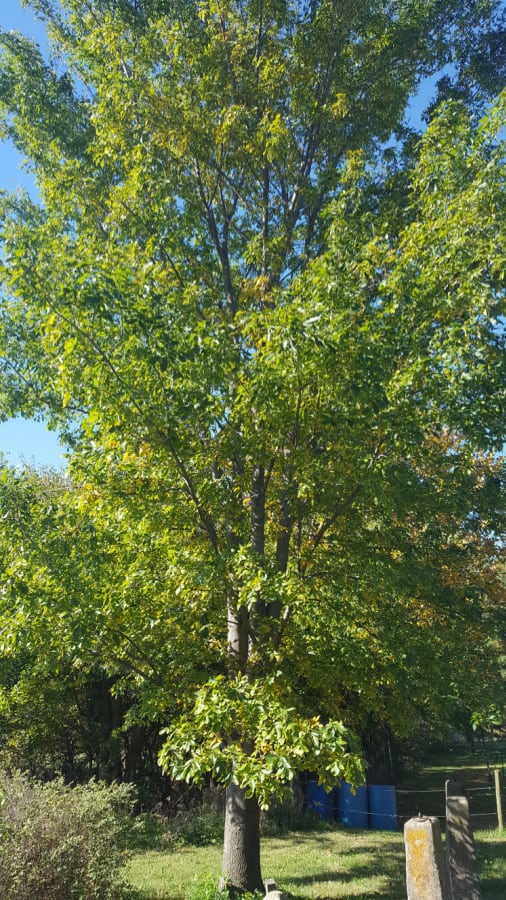
Black Walnut
While black walnut may not be the best choice for shade, for every landscape, it can be in some. In my own yard, I have several black walnuts that edge the eastern and western sides of the property. They provide an interesting shade aspect in the garden. Most shade loving perennials will grow under them without an issue. The grow 1 to 3 feet per year.
- Black walnut grows 50 to 80 feet tall and wide with a rounded crown.
- It grows well in a variety of soils, but prefers well-drained, silt loams, and moist bottomlands. They are not tolerant of flooding.
- The flowers are greenish and insignificant. Fruit is larger than a ping pong ball and contains an edible nut. Leaves can be messy in fall.
- Fall color is usually brown, rarely yellow.
- Thousand cankers is a disastrous disease which is spreading in the United States. There are no serious insect pests, though fall webworm can defoliate the tree.
- More than 20 species of moth use black walnut as a host plant.
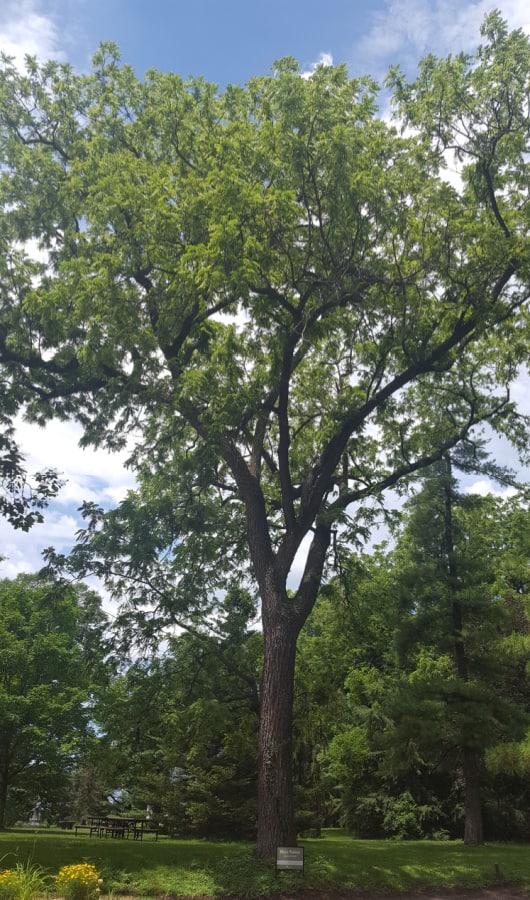
Sugar Maple
The sugar maple is one of my favorite shade trees, mainly because you get maple syrup and for their wonderful fall foliage. They are perhaps underrated because of the growth rate of hybrid maples, but they outshine those in autumn. Sugar maples grow between 1 and 3 feet per year.
- They grow 40 to 80 feet tall by 40 to 60 feet wide, with an oval crown.
- Sugar maples can grow in moist, well-drained, or heavy clay soils without issues. They do not like flooding.
- The flowers are small, usually yellow, and not very showy. Fruit is rare, as an elongated samara.
- Fall color can be red, orange, yellow, or a mixture of colors.
- There are no major diseases or insect pests.
- More than 35 moth species utilize it as a host plant.
- Good cultivars: ‘Oregon Trail‘, ‘Legacy’, ‘Caddo’, ‘Fireside’
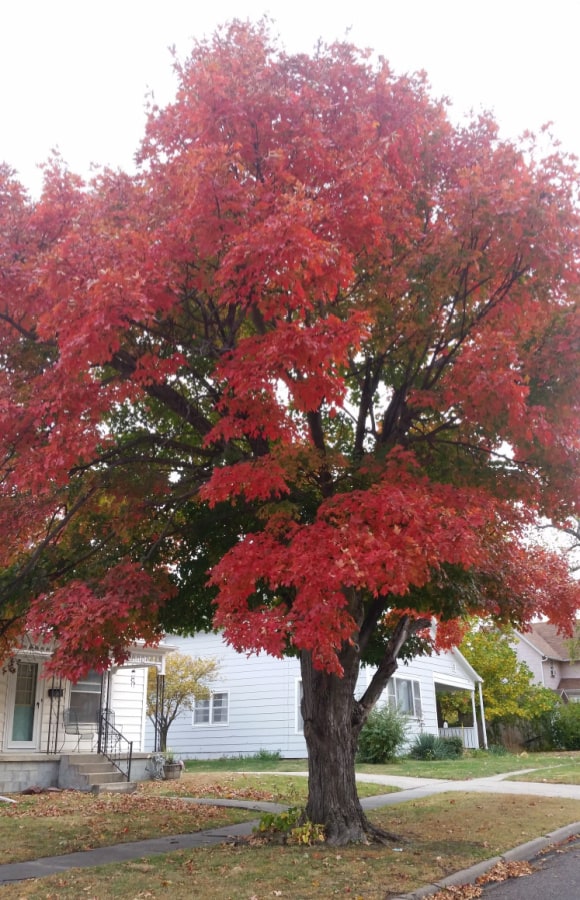
Common Hackberry
While this is certainly not considered a great tree by many nurseries, it is one of my favorites. The bark is its best feature, having tall ridges. The leaves are light to dark green and often get galls, but it is still a hardy, large, shade tree. Hackberry grows 1 to 3 feet per year.
- It grows 50 to 100 feet tall and wide with a vase shaped crown.
- Hackberries prefer well drained soil, but is adaptable to clay and moist soils.
- Flowers are insignificant, and the fruit is a small, hard berry, about the size of a pea.
- Fall color is yellow to brown.
- There are no serious diseases or insect pests, though nipple gall psyllids are unsightly.
- At least 5 butterflies use it as a host plant, plus several moths.
- Good cultivars: ‘Magnifica‘, ‘KC Streetview’
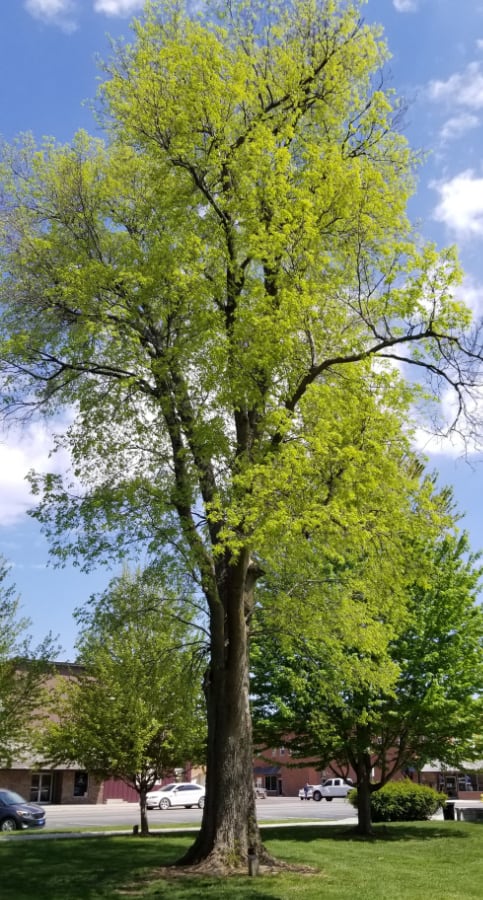
Ginkgo
The ginkgo is considered a living fossil tree, though many other trees are just as old as it is. The leaves are unique, being fan shaped, and the bark is slightly ribbed. There is nothing quite like an older ginkgo for shade and fall glory. They grow 6 inches to 2 feet per year.
- The ginkgo can grow 60 to 120 feet tall and wide. They have a vase shaped crown.
- They grow best in well-drained soil, but are adaptable to other soils.
- Flowers are insignificant, and fruit is only on female trees. The fruit is quite rancid in smell.
- Fall color is brilliant golden yellow, perhaps the best yellow fall color.
- There are no diseases or pest problems.
- Good cultivars: ‘Princeton Sentry’, ‘Asian Princess‘, ‘Autumn Gold‘, ‘Presidential Gold’
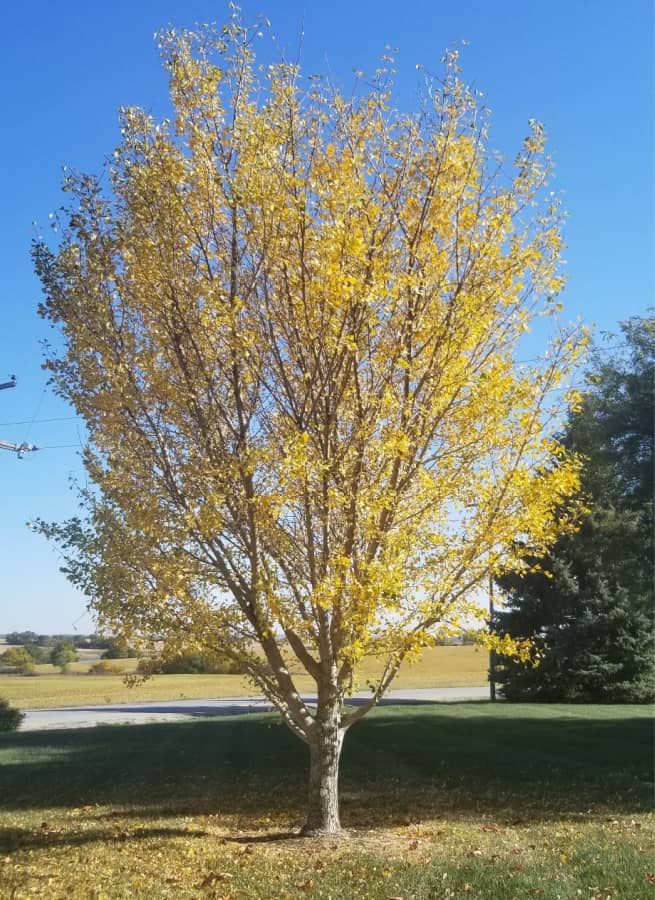
Sweetgum
This is perhaps the best recommendation for a fall color replacement for our white ash tree. However, the fruit makes it less desirable. Sweetgums are narrow, upright trees that grow 1 to 3 feet per year.
- They grow 40 to 80 feet tall by 20 to 60 feet wide with a narrow, oval crown.
- Sweetgums grow best in moist to well-drained soil, but are adaptable to heavy clay.
- The flowers are small and insignificant, but the fruit is a sticky, pointy ball about the size of a golf ball.
- Fall color has shades of purple, yellow, and maroon.
- There are no serious diseases or pest problems.
- Only a handful of moths use it as a host plant.
- Good cultivars: ‘Rotundiloba’, ‘Silver King’, ‘Slender Silhouette’
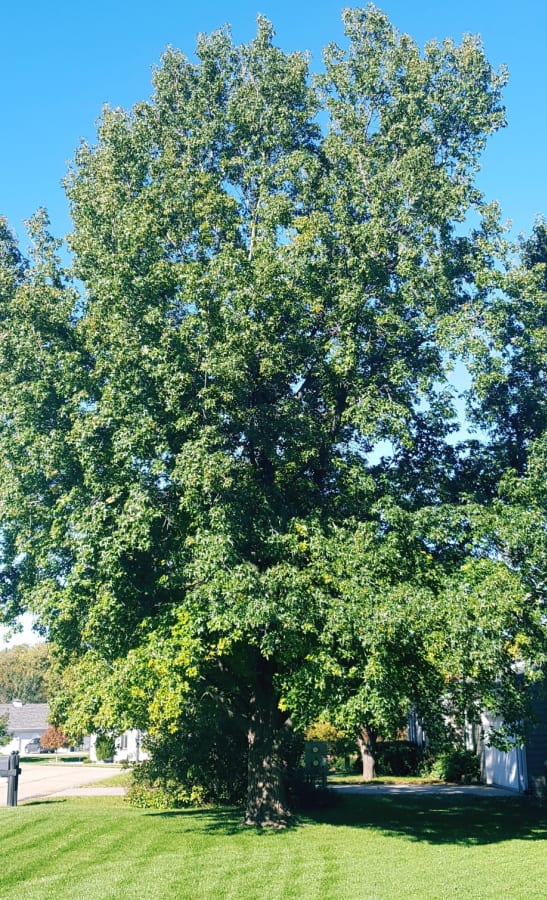
Osage Orange
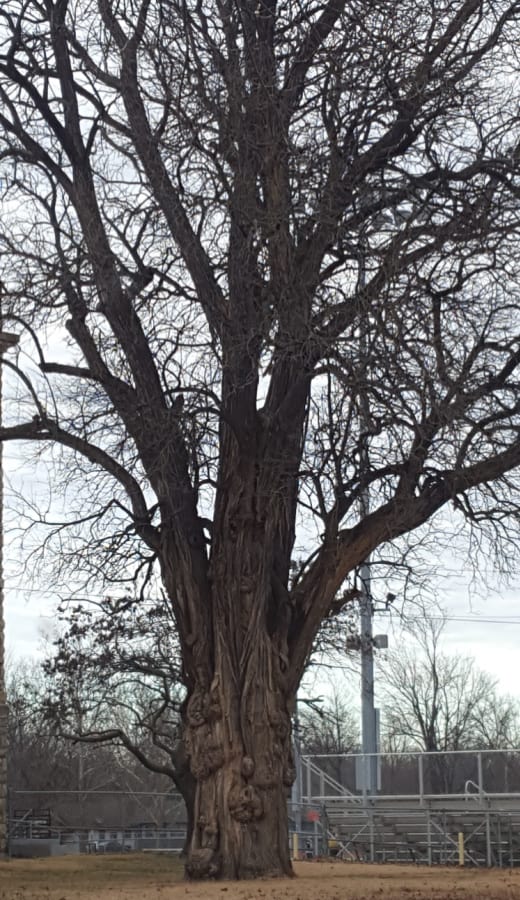
If you can be sure to get a male cultivar of the hedge, or Osage Orange tree, then you have a special tree indeed. I have a large, male tree on the edge of the property line between us and my eastern neighbors. It is quite a beautiful tree. Osage orange trees grow 1 to 6 feet per year for the first 10 to 15 years, then slow to 1 to 3 feet per year.
- They grow 40 to 60 feet tall and wide with a rounded crown.
- Osage orange trees are adaptable to many soils, drought, and heavy clay. They do not like standing water or flooding.
- The flowers are small and insignificant. Fruit on female trees can be tiny to huge, from 3 inches to 10 inches in diameter, and very sticky.
- Fall color is yellow.
- There are no serious diseases or insect pests.
- Only a few moths use it as a host plant.
- Good cultivars: ‘White Shield‘, ‘Wichita’, ‘KC Fence Post’
Honeylocust
If you get one of the native trees from a woodlot, then you will be disappointed by the large thorns, more than 3 inches long. But many cultivars are available without thorns, and make great landscape shade trees. The bark is ridged and pretty. They grow 1 to 3 feet per year.
- Honeylocust grows 40 to 70 feet tall and wide, with a rounded crown.
- They are adaptable to many soils, but grow best in well-drained soil.
- Flowers are small and not showy. Seedpods are annoying, but many cultivars are seedless.
- There are no major diseases or insect pests.
- More than 15 moths use honeylocust as a host plant.
- Good cultivars: ‘Shademaster’, ‘Sunburst‘
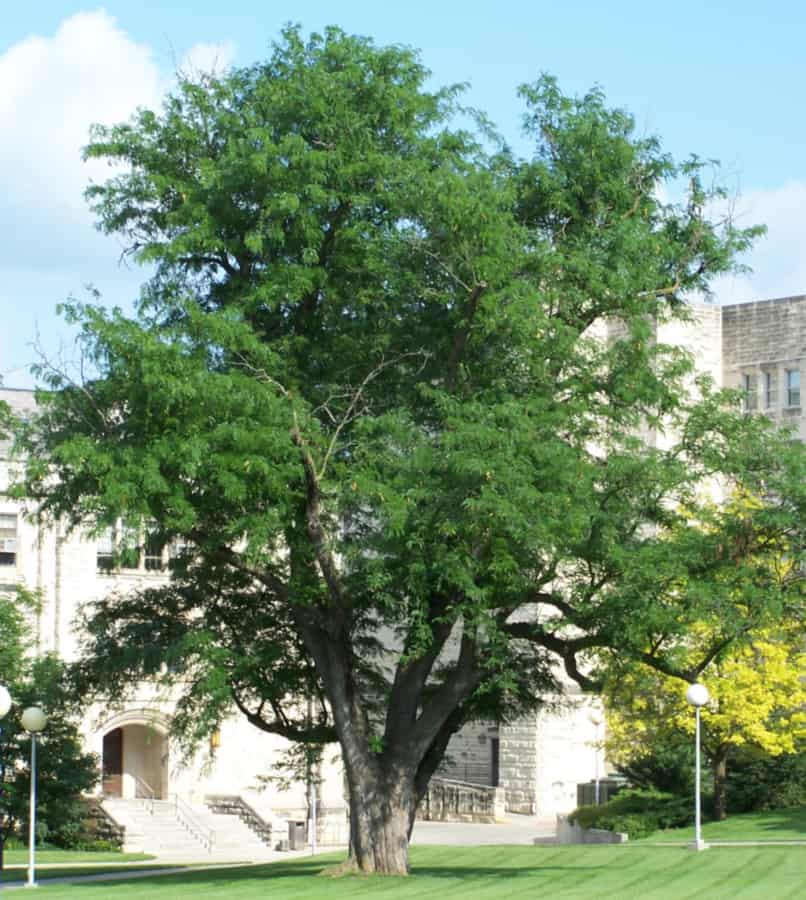
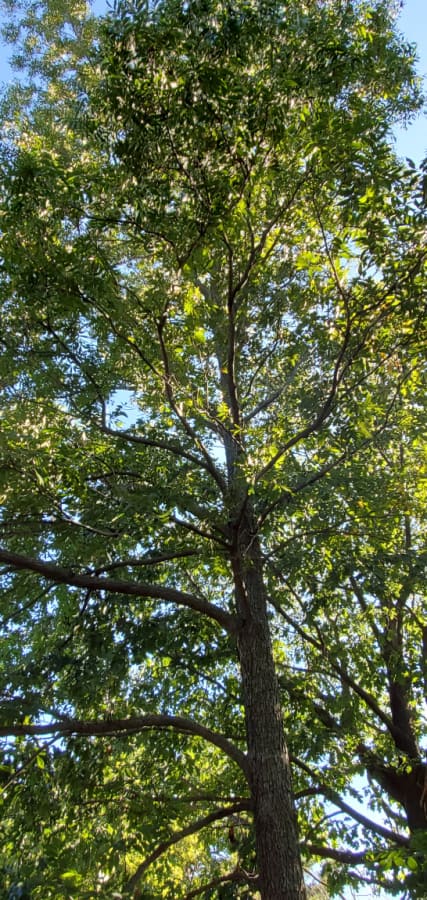
Pecan
Another nut tree for shade? Yes, because the pecan is a large tree, and the nuts are usually eaten by squirrels well before they become too messy in the landscape. Pecans have hard wood, and grow 1 to 2 feet per year.
- They grow 50 to 100 feet tall and wide with a vase shaped crown.
- Pecans grow best in well-drained, deep and moist soils, but are adaptable to dry and heavy clay soils.
- Flowers are yellow catkins, not showy, and followed by edible nuts.
- There are no major diseases or pest issues.
- Several moth species use the pecan as a host plant.
- Good cultivars: ‘Major’, ‘Peruque‘, ‘Elliott’, ‘Colby‘
Oaks
There are many different oaks which would work well as large shade trees. Please refer to an earlier post for which one to choose. You can find that post HERE.
Conclusion
There are and will always be many different trees to choose from. Just remember to look at your site conditions first, then look at this and other guides to find the right tree. “Life is a shade better under a tree”.
Happy planting!
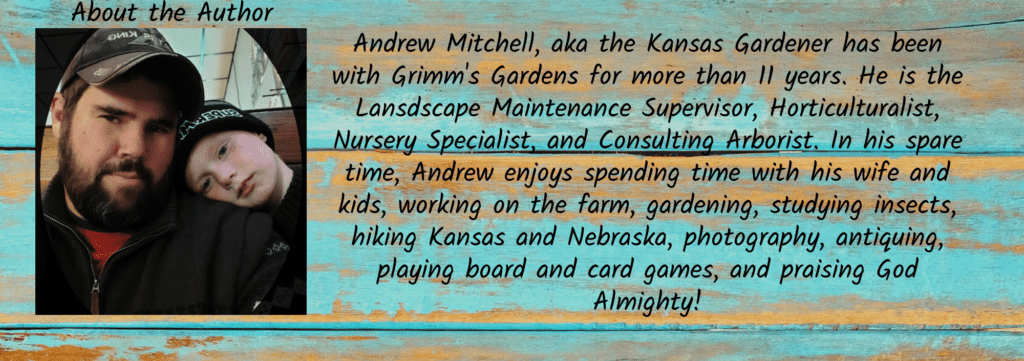




Thank you Andrew. Very informative!